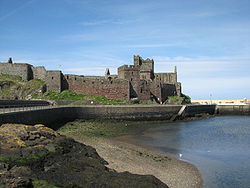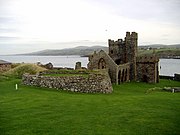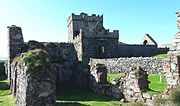
The Isle of Man or Mann, is a self-governing British Crown Dependency in the Irish Sea, between Great Britain and Ireland. It is recognised as one of the Celtic nations and is the homeland of the Manx people, a Celtic ethnic group. As head of state, Charles III holds the title Lord of Mann and is represented by a Lieutenant Governor. The government of the United Kingdom is responsible for the Isle of Man's military defence and represents it abroad, but the Isle of Man still has a separate international identity.

Castletown is a town in the Isle of Man, geographically within the historical parish of Malew but administered separately. Lying at the south of the island, it was the Manx capital until 1869. The centre of town is dominated by Castle Rushen, a well-preserved medieval castle, originally built for a Viking king.

Peel is a seaside town and small fishing port in the Isle of Man, in the historic parish of German but administered separately. Peel is the third largest town in the island after Douglas and Ramsey but the fourth largest settlement, as Onchan has the second largest population but is classified as a village.
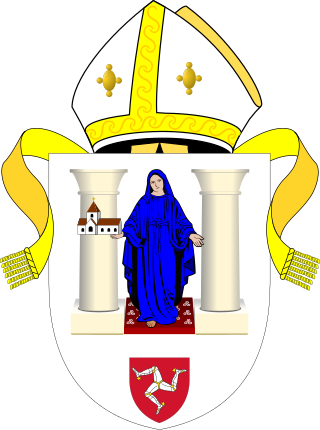
The Diocese of Sodor and Man is a diocese of the Church of England. Originally much larger, today it covers just the Isle of Man and its adjacent islets. Today, the bishop's office is in Douglas and the cathedral is in Peel. The diocese is not generally called either "Sodor diocese" or "Man diocese".

St Patrick's Isle is a small tidal island on the west coast of the Isle of Man in the Irish Sea, largely occupied by the ruins of Peel Castle and of the Pre-Reformation Cathedral of the Diocese of the Isles.

The Cathedral Church of Saint German or Peel Cathedral, renamed Cathedral Isle of Man, is located in Peel, Isle of Man. The cathedral is also one of the parish churches in the parish of the West Coast, which includes the town of Peel. Built in 1879–84, it was made the cathedral by Act of Tynwald in 1980.

The culture of the Isle of Man is influenced by its Celtic and, to a lesser extent, its Norse origins, though its close proximity to the United Kingdom, popularity as a UK tourist destination, and recent mass immigration by British migrant workers has meant that British influence has been dominant since the Revestment period. Recent revival campaigns have attempted to preserve the surviving vestiges of Manx culture after a long period of Anglicisation, and significant interest in the Manx language, history and musical tradition has been the result.
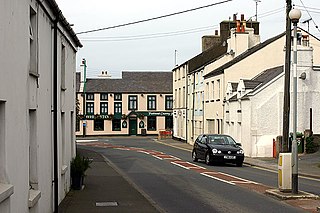
Ballasalla is a village in the parish of Malew in the south-east of the Isle of Man. The village is situated close to the Isle of Man Airport and 2 miles (3 km) north-east of the town of Castletown.

Piel Castle, also known as Fouldry Castle or the Pile of Fouldray, is a castle situated on the south-eastern point of Piel Island, off the coast of the Furness Peninsula in north-west England. Built in the early-14th century by John Cockerham, the Abbot of neighbouring Furness Abbey, it was intended to oversee the trade through the local harbour and to protect against Scottish raids. The castle was built using stones from the local beach, and featured a large keep with surrounding inner and outer baileys. It was used as a base by the Yorkist pretender Lambert Simnel in 1487, but by 1534 it had fallen into ruin and passed into the hands of the Crown.
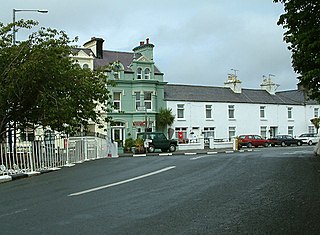
Ballaugh is a small village in the Isle of Man in the parish of the same name, in the sheading of Michael. It is the only village in the parish.
John Phillips was the Anglican Bishop of Sodor and Man between 1604 and 1633. He is best known for writing the first dateable text in the Manx language in his translation of the 1604 Book of Common Prayer in 1610.
Mark Hiddesley or Hildesley was an Anglican churchman. He served as vicar of Hitchin in Hertfordshire and later as Bishop of Sodor and Man between 1755 and 1772, where he encouraged Bible translations into Manx.
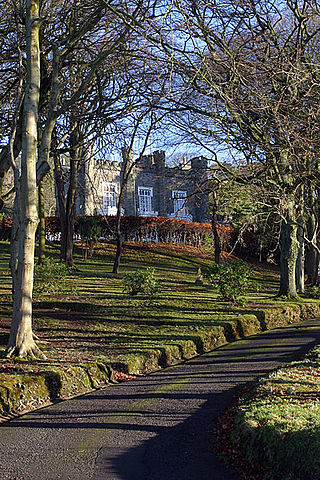
Greeba Castle is a castle on the Isle of Man.
Isaac Barrow was an English clergyman who served, consecutively, as Bishop of Sodor and Man and Bishop of St Asaph, and also served as Governor of the Isle of Man. He was the founder of the Bishop Barrow Trust. During his time as Bishop of Sodor and Man and Governor of the Isle of Man, he enacted significant social, political, and ecclesiastical reforms. He is sometimes confused with his more famous namesake and nephew, Isaac Barrow (1630–1677), the mathematician and theologian.
Samuel Rutter was Bishop of Sodor and Man between 1661 and 1662.

Bishopscourt consists of a 17th-century mansion house, the St Nicholas in the Church of England Diocese of Sodor and Man, and the former estate of Ballachurry or Bishopscourt Manse.

The Bishop of Sodor and Man is the Ordinary of the Diocese of Sodor and Man in the Province of York in the Church of England. The diocese only covers the Isle of Man. The Cathedral Church of St German where the bishop's seat is located, is in the town of Peel. St German's was elevated to cathedral status on 1 November 1980.
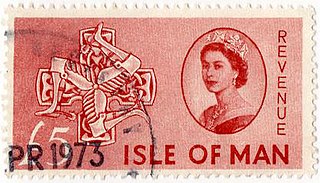
Revenue stamps of the Isle of Man refer to the adhesive revenue or fiscal stamps which were issued by the British Crown dependency of the Isle of Man between 1889 and 1976. British key type revenue stamps with an appropriate inscription were issued on the island until 1966, when revenue stamps showing various scenes and symbols of the island began to be issued. The last set of stamps was issued in 1976. From around 1920 to the 1970s, hundreds of contribution stamps were issued for National Insurance and related schemes.

The St Mary of the Isle Cathedral, also referred to as the Cathedral of St Mary of the Isle, is a Roman Catholic cathedral in Douglas, Isle of Man. It is part of the Roman Catholic Pastoral Area of St Maughold within the Archdiocese of Liverpool. It is one of two cathedrals on the Island, and one of six Catholic churches. It is referred to locally as St. Mary's. In September 2023, St Mary of the Isle was granted co-cathedral status.

St Trinian's Church is the roofless ruin of a small chapel at the foot of Greeba Mountain, adjacent to the main A1 Douglas - Peel Road in the parish of Marown, Isle of Man. Referred to in the Manx language as a "Keeil Brisht", the church is the source of an ancient Manx folktale concerning the Buggane, a huge mythical ogre who lived on Greeba Mountain and who vowed that the church should never be completed.
